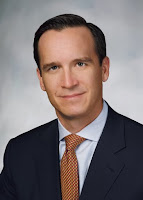The Fed’s 'Financial Conditions' Conundrum
By Jason Brady, Guest Contributor
First-quarter returns marked a spectacular rebound from the December 26 lows, when investors were fleeing risk exposures. Many markets saw their best quarter in a decade. We’re back!
Not so fast. Markets and the U.S. Federal Reserve face a multifaceted conundrum: Where exactly are we in the economic cycle? Can we be late cycle but still have room to grow? Ex-energy, have we reached inflation targets, or is deflation still the concern? Is the labor market tight, as former Fed Chairwoman Janet Yellen recently said, or does significant slack still exist, as some current Fed officials assert? Excesses have built up, including corporate leverage and re-compressed yields, amid renewed investor risk appetite. After the selloff and subsequent rebound, should investors expect less volatility, or more?
Toward the end of her tenure, Yellen called out the excesses, but they haven’t become less spicy since current Fed Chairman Jerome Powell took over in early 2018. Risk markets suffered after the Fed hiked four times in 2018 and steadily shrank its still-bloated balance sheet. But since Powell’s end-2018 policy U-turn, the Fed’s focus now appears trained more on ebbing, albeit still decent, global growth and especially “financial conditions,” which nowadays means equity markets.
Stock prices are higher thanks to the Fed, not because earnings are better or growth is terrific. Ironically, U.S. blue-chip earnings rose last year, and price/earnings ratios declined. This year, it’s the inverse. Too often investors extrapolate the latest Fed signal out to the long run. That’s why we’re skeptical about the Fed’s about-face, which engendered hope its still-accommodative stance will long continue amid above-trend growth.
The Fed’s liquidity injections—not to mention those of the other major central banks—have fended off some problems. But they won’t produce higher growth if we can’t push credit creation further, a challenge when debt levels are running high globally. Typically, when the Fed is finished hiking, a relief rally ensues. Yet the close of an economic cycle isn’t good news.
Valuations don’t offer much support to equities or fixed income. When rates rose in 2018, it caused risk assets to falter because we are now dependent on ever-lower interest costs with debt burdens of corporations and governments quite high. The U.S. 10-year Treasury yield’s 80-basis-point fall helps. But most of the world is at the zero lower bound. Curves are flat or inverted not because there is imminent doom. Rather, markets expect medium-term rates to be lower to deal with a future downturn. Ultimately, this cycle won’t die of old age. It will die because we have borrowed and pulled forward growth, creating conditions for “Minsky Moment” instability.
Markets adjusting to better reflect current fundamentals and future prospects shouldn’t be cause for Fed capitulation amid above-trend growth. Nor should investors want rising valuations from easy money, absent improving fundamentals. Spotting the difference is crucial for successful investing.
The views expressed herein do not constitute research, investment advice or trade recommendations and do not necessarily represent the views of Thornburg Investment Management or TEXPERS.
About the Author:
 |
| Jason Brady |
Jason Brady is president and CEO of Thornburg Investment Management. He is responsible for the company’s overall strategy and direction. He is also the head of the firm’s global fixed income investment team and a portfolio manager on multiple strategies. He joined the firm in 2006, was made portfolio manager and managing director in 2007, and president and CEO in 2016. His book, "Income Investing: An Intelligent Approach to Profiting from Bonds, Stocks and Money Markets," is a step-by-step guide to income investing. Brady holds a bachelor's degree with honors in English and environmental biology from Dartmouth College, and an master's degree with concentrations in analytical finance and accounting from Northwestern’s Kellogg Graduate School of Management. He is a CFA charterholder. Prior to joining Thornburg, Brady was a portfolio manager with Fortis Investments in Boston, and has held various positions at Fidelity Investments and Lehman Brothers.

No comments:
Post a Comment